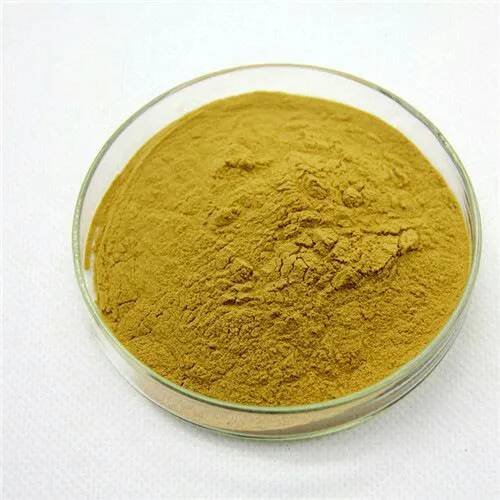- 0086-571-85302990
- sales@greenskybio.com
The Best Method for Extracting Echinacea Extract.
2024-11-29

1. Introduction to Echinacea Extract
Echinacea, also known as purple coneflower, has been widely studied for its potential health benefits. The extract of echinacea contains various bioactive compounds such as alkamides, caffeic acid derivatives, and polysaccharides. These compounds are believed to contribute to its immunomodulatory, anti - inflammatory, and antioxidant properties. As the demand for natural health products increases, the extraction of Echinacea Extract has become an important area of research.

2. Scientific Research Perspective
2.1. Understanding the Bioactive Compounds
Before discussing the extraction methods, it is crucial to understand the nature of the bioactive compounds in echinacea. Alkamides are lipid - soluble compounds that play a significant role in the immunomodulatory effects of echinacea. They are sensitive to heat and certain chemical solvents. Caffeic acid derivatives, such as echinacoside and cichoric acid, are phenolic compounds with antioxidant properties. Polysaccharides are large carbohydrate molecules that are associated with the immune - enhancing effects. Different extraction methods may have different effects on the extraction of these compounds.
2.2. Analytical Techniques for Extract Evaluation
To ensure the quality of the Echinacea Extract, various analytical techniques are used. High - performance liquid chromatography (HPLC) is commonly employed to analyze the content of caffeic acid derivatives. Gas chromatography - mass spectrometry (GC - MS) can be used for the analysis of alkamides. For polysaccharides, methods such as size - exclusion chromatography and spectrophotometric assays are utilized. These techniques help in determining the extraction efficiency and the integrity of the bioactive compounds.

3. Industrial Production Perspective
3.1. Solvent Extraction
- Ethanol Extraction: Ethanol is a commonly used solvent for echinacea extraction. It has the advantage of being relatively safe, and it can dissolve a wide range of bioactive compounds. In industrial settings, a certain concentration of ethanol (usually 40 - 70%) is mixed with dried echinacea plant material. The mixture is then stirred or refluxed for a specific period, typically several hours. For example, a study showed that extraction with 50% ethanol at a reflux temperature of 80°C for 3 hours resulted in a good yield of alkamides and caffeic acid derivatives.
- Hexane Extraction: Hexane is mainly used for the extraction of lipid - soluble compounds such as alkamides. However, it has the drawback of being a non - polar solvent, which may not extract polar compounds effectively. Hexane extraction is often followed by a second extraction step with a more polar solvent to obtain a more complete extract.
3.2. Supercritical Fluid Extraction (SFE)
Supercritical carbon dioxide (CO₂) is a popular choice for SFE in the extraction of echinacea. The process operates at a specific temperature and pressure where CO₂ is in a supercritical state. This method has several advantages. It is a clean and environmentally friendly process as CO₂ is non - toxic and can be easily removed from the extract. It also offers good selectivity, which means it can target specific bioactive compounds. For example, by adjusting the pressure and temperature, it is possible to preferentially extract alkamides while minimizing the extraction of unwanted components. However, the equipment for SFE is relatively expensive, which may limit its widespread use in small - scale industries.

4. Environmental Protection Perspective
4.1. Green Solvents
- Ionic Liquids: Ionic liquids are emerging as potential green solvents for echinacea extraction. They have unique properties such as low volatility and high solubility for a wide range of compounds. However, their high cost and potential toxicity need to be further investigated before large - scale industrial application.
- Deep Eutectic Solvents (DES): DES are formed by mixing a hydrogen - bond donor and a hydrogen - bond acceptor. They are considered more environmentally friendly than traditional organic solvents. Some DES have shown promise in the extraction of echinacea, but more research is needed to optimize the extraction conditions and to ensure the safety of the extract.
4.2. Waste Management
During the extraction process, waste materials are generated. In solvent extraction, proper disposal of used solvents is necessary to prevent environmental pollution. In the case of plant residues, they can be potentially recycled for other applications such as composting or biofuel production. For example, the leftover echinacea plant material after extraction can be composted to enrich the soil, which is an environmentally friendly way of waste management.

5. Balancing Extraction Yield and Bioactivity
5.1. Optimization of Extraction Conditions
- Temperature: The extraction temperature can significantly affect both the yield and the bioactivity of the extract. Higher temperatures may increase the extraction rate, but they can also lead to the degradation of heat - sensitive compounds such as alkamides. For example, in ethanol extraction, a temperature between 50 - 70°C may be a good compromise to achieve a relatively high yield while maintaining the integrity of the bioactive compounds.
- Time: The extraction time also needs to be optimized. Longer extraction times may increase the yield, but it can also introduce impurities or cause the degradation of bioactive compounds. In most cases, an extraction time of 2 - 4 hours is considered appropriate for echinacea extraction.
- Particle Size: Reducing the particle size of the echinacea plant material can increase the surface area available for extraction, thus potentially increasing the yield. However, extremely fine particles may cause problems such as clogging in the extraction equipment. A particle size in the range of 0.5 - 2 mm is often used in industrial extraction.
5.2. Combined Extraction Methods
Combining different extraction methods can be an effective way to balance extraction yield and bioactivity. For example, a two - step extraction process where an initial hexane extraction is followed by an ethanol extraction can help in extracting both lipid - soluble and polar bioactive compounds. Another approach is to combine solvent extraction with a non - thermal extraction method such as ultrasonic - assisted extraction. Ultrasonic waves can disrupt the plant cell walls, facilitating the release of bioactive compounds without the need for high temperatures, thus maintaining their bioactivity.
6. Conclusion
The extraction of echinacea extract is a complex process that needs to be considered from multiple perspectives. From scientific research, we understand the nature of the bioactive compounds and the importance of analytical techniques for quality control. In industrial production, solvent extraction and supercritical fluid extraction are the main methods, each with its own advantages and limitations. From an environmental protection perspective, the use of green solvents and proper waste management are crucial. To balance extraction yield and bioactivity, optimization of extraction conditions and combined extraction methods are effective strategies. Future research should focus on further improving the extraction methods to meet the increasing demand for high - quality echinacea extract while minimizing the environmental impact.
FAQ:
Q1: What are the common solvents used in echinacea extract extraction?
Common solvents include ethanol, water, and sometimes a combination of both. Ethanol is often preferred as it can effectively dissolve the active compounds in echinacea while also having some antimicrobial properties. Water - based extraction is also considered, especially in cases where a more natural or green" extraction method is desired. Additionally, other solvents like methanol may be used in some research settings, but ethanol and water are the most widely used in both industrial and laboratory extractions.
Q2: How does temperature affect the extraction of echinacea extract?
Temperature plays a crucial role. Higher temperatures generally increase the solubility of the active compounds in the solvent, which can lead to a higher extraction yield. However, excessive heat can also degrade some of the bioactive components in echinacea. Therefore, an optimal temperature range needs to be determined. In industrial production, precise temperature control is often implemented to balance between maximizing yield and maintaining the quality of the extract. In laboratory - scale extractions, different temperature levels are often tested to find the best conditions for a particular extraction method.
Q3: What are the main bioactive compounds in echinacea extract and how can their bioactivity be preserved during extraction?
The main bioactive compounds in echinacea include alkamides, caffeic acid derivatives, and polysaccharides. To preserve their bioactivity during extraction, gentle extraction methods should be used. For example, avoiding extreme pH levels, high temperatures for a long time, and strong oxidizing agents. Using mild solvents and short extraction times can also help. Additionally, some antioxidants can be added during extraction to prevent the oxidation of the bioactive compounds.
Q4: Are there any new or emerging extraction techniques for echinacea extract?
Yes, there are some emerging techniques. Supercritical fluid extraction (SFE) is one of them. It uses supercritical carbon dioxide as the solvent, which has the advantages of being non - toxic, non - flammable, and having a relatively low critical temperature. This method can provide a high - quality extract with good selectivity for the active compounds. Another emerging technique is ultrasound - assisted extraction. Ultrasound can enhance the mass transfer between the solid echinacea matrix and the solvent, resulting in a shorter extraction time and potentially higher yield while maintaining the bioactivity of the extract.
Q5: How can the extraction of echinacea extract be made more environmentally friendly?
To make the extraction more environmentally friendly, the choice of solvent is crucial. Using water - based extraction or bio - based solvents can reduce the environmental impact. Also, optimizing the extraction process to reduce waste and energy consumption is important. For example, recycling the solvent, using energy - efficient extraction equipment, and reducing the amount of raw materials used. Additionally, in - situ extraction methods that can be carried out on the farm where echinacea is grown can reduce transportation and associated emissions.
Related literature
- "Optimization of Echinacea purpurea Extract Production: A Review of Extraction Methods"
- "Bioactive Compounds in Echinacea Extract: Extraction and Preservation"
- "Echinacea Extract: Sustainable Extraction for Industrial Applications"
- ▶ Hesperidin
- ▶ citrus bioflavonoids
- ▶ plant extract
- ▶ lycopene
- ▶ Diosmin
- ▶ Grape seed extract
- ▶ Sea buckthorn Juice Powder
- ▶ Beetroot powder
- ▶ Hops Extract
- ▶ Artichoke Extract
- ▶ Reishi mushroom extract
- ▶ Astaxanthin
- ▶ Green Tea Extract
- ▶ Curcumin Extract
- ▶ Horse Chestnut Extract
- ▶ Other Problems
- ▶ Boswellia Serrata Extract
- ▶ Resveratrol Extract
- ▶ Marigold Extract
- ▶ Grape Leaf Extract
- ▶ blog3
- ▶ blog4
-
High - quality lily extract products.
2024-11-29
-
Organic Clove Powder Factory.
2024-11-29
-
Chinese suppliers of chastity berry extract.
2024-11-29
-
100% Organic Aged Garlic Extract.
2024-11-29
-
Chinese Chastity Berry Extract Factory.
2024-11-29
-
Grape Leaf Extract
2024-11-29
-
Bitter Melon Extract
2024-11-29
-
Quercetin
2024-11-29
-
Genistein
2024-11-29
-
Shikonin
2024-11-29
-
Hawthorn Extract
2024-11-29
-
Boswellia Serrata Extract
2024-11-29
-
Saponin Extract
2024-11-29
-
Beta Carotene
2024-11-29
-
Troxerutin
2024-11-29





















